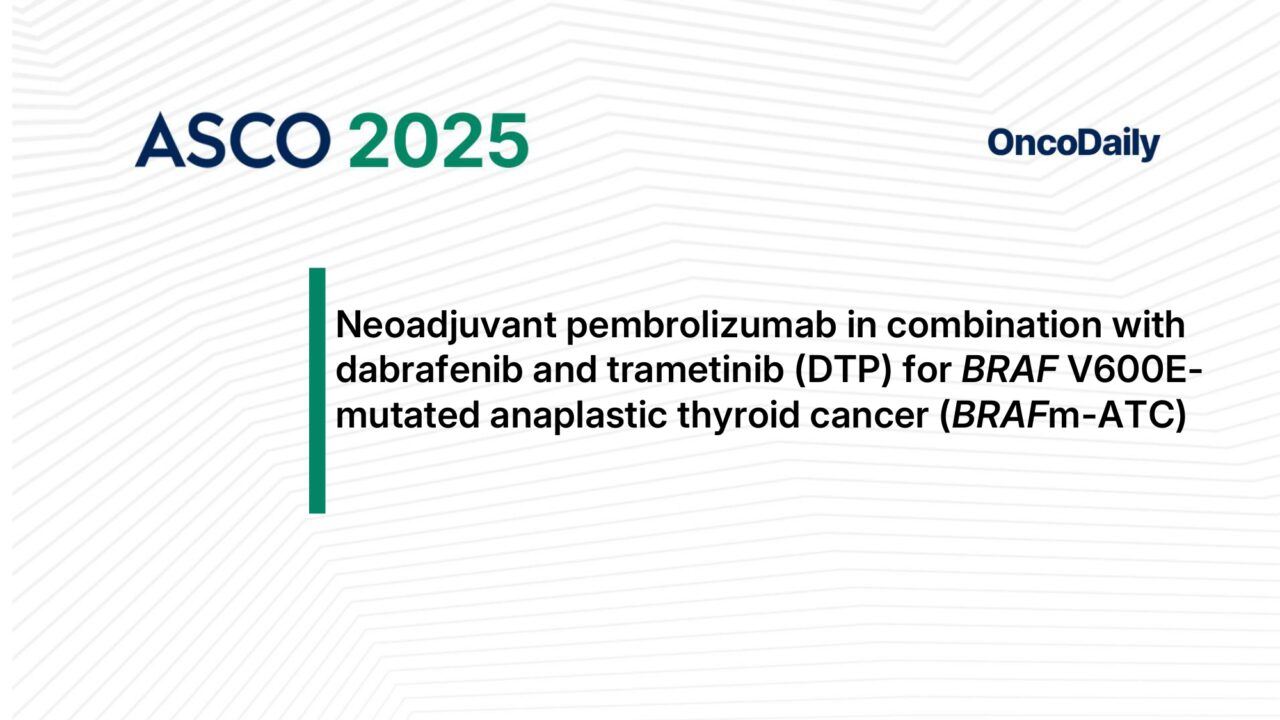
Trial Updates at ASCO 2025: Neoadjuvant Pembrolizumab, Dabrafenib, and Trametinib in BRAF V600E-Mutated ATC
Neoadjuvant DTP in BRAFm-ATC was presented at ASCO 2025 by Dr. Mark Zafereo of The University of Texas MD Anderson Cancer Center. He presented landmark results from a multicenter Phase II trial investigating a neoadjuvant triplet regimen—dabrafenib, trametinib, and pembrolizumab (DTP)—in patients with BRAF-mutated anaplastic thyroid cancer (BRAFm-ATC) at ASCO 2025. The study demonstrated remarkable improvements in resectability, pathological response, and survival compared to historical outcomes in this notoriously aggressive malignancy. These findings position neoadjuvant DTP as a potential new standard of care in BRAFm-ATC.
Background
Anaplastic thyroid carcinoma (ATC) is among the most lethal solid tumors, frequently presenting at advanced stages with unresectable disease. Median overall survival (OS) remains dismal, and effective treatment strategies have been limited. In the ROAR trial, combination BRAF/MEK inhibition without immune checkpoint blockade yielded a median PFS and OS of 6.7 and 13.5 months, respectively. Retrospective series have shown that neoadjuvant DTP (dabrafenib, trametinib, and pembrolizumab) may facilitate locoregional control and resection in BRAFm-ATC. This provided a compelling rationale to prospectively evaluate this triplet therapy in a phase II setting.
Methods and Study Design
This investigator-initiated, multicenter, single-arm Phase II trial enrolled patients with stage IVB or IVC BRAFm-ATC across five U.S. academic centers between September 2021 and January 2025. Eligible patients received dabrafenib (150 mg BID) and trametinib (2 mg daily) for a 3–6 week run-in, followed by pembrolizumab (200 mg every 3 weeks) added to the regimen. Imaging was performed after every three cycles (21-day cycles) to assess radiographic response. Following neoadjuvant therapy, patients were re-evaluated for surgical resection. Post-operatively, patients either received radiation with pembrolizumab or continued DTP for up to 26 total cycles.
The primary endpoints were:
- R0/R1 surgical resection rate, benchmarked against a historical rate of 5%
- Overall survival (OS)
Secondary endpoints included:
- Radiographic response by RECIST 1.1
- Progression-free survival (PFS)
- Surgical morbidity scores
- Safety
Of 42 patients enrolled, 36 were included in this interim analysis (3 not evaluable, 3 awaiting surgery).
Results
This multicenter Phase II trial provides compelling evidence that neoadjuvant dabrafenib, trametinib, and pembrolizumab can convert unresectable BRAFm-ATC to operable status and significantly improve patient outcomes. With high resection rates, deep pathological responses, and encouraging survival data, DTP should now be considered a new standard of care for BRAF-mutated anaplastic thyroid cancer. Further studies may refine patient selection and explore combinations with radiation or additional immunotherapy agents.
The median age of patients enrolled in the study was 67 years, with a range spanning from 46 to 86 years. In terms of disease stage, 42% of patients had stage IVB disease, while the remaining 58% were classified as stage IVC.
Neoadjuvant treatment response:
- Median of 4 DTP cycles (range: 2–7)
Radiographic response:
- Partial response (PR): 24/36 (67%)
- Complete response (CR): 2/36 (6%)
- Stable disease (SD): 6/36 (17%)
- Progressive disease (PD): 4/36 (11%)
- Mean tumor shrinkage: −44% (95% CI: −54%, −34%)
Surgical outcomes:
- 30/36 (83%) underwent surgery
- 29/30 (97%) achieved R0/R1 resection
- Mean surgical morbidity score improved from 3.3 to 1.6 (−1.7, 95% CI: −2.1 to −1.3, p<0.01)
- Pathologic complete response (pCR): 20/30 (67%)
- Residual ATC in resected tumor: 10/30 (33%)
Adjuvant treatment:
- 11/30 (37%) received adjuvant neck radiation
- 28/36 (78%) completed a median of 11 DTP cycles post-operatively
Survival outcomes (median follow-up: 18 months):
- Median OS: 20 months (95% CI: 12.6–not reached)
- 1-year OS: 71%; 2-year OS: 48%
- Median PFS: 13.9 months (95% CI: 7.5–NR)
- 1-year PFS: 57%; 2-year PFS: 36%
- 2-year OS for pCR vs residual ATC: 69% vs 22% (p=0.02)
A total of 8 out of 36 patients (22%) experienced grade 5 adverse events. Among these, one case was possibly treatment-related, involving a duodenal perforation, and one was deemed probably related, involving acute kidney injury accompanied by sepsis. The remaining six events were assessed as unlikely or unrelated to the study treatment.
Key Findings
- Neoadjuvant DTP enabled surgical resection in 83% of patients with previously inoperable BRAFm-ATC.
- The R0/R1 resection rate of 97% far exceeds historical benchmarks (~5%).
- Pathologic complete response occurred in two-thirds of resected patients.
- Median OS reached 20 months, surpassing outcomes seen with prior dual therapy.
- Surgical morbidity was significantly reduced, improving feasibility of curative surgery.
- Pathologic response correlated strongly with survival outcomes.
Key Takeaway Messages
- DTP triplet therapy transforms the therapeutic landscape for BRAF-mutant ATC.
- Surgery becomes feasible in the majority of patients after neoadjuvant DTP.
- The strategy yields meaningful survival extension in a disease with few options.
- Pathologic complete response is prognostic of long-term survival benefit.
- The approach is tolerable, though not without risk—ongoing safety monitoring is essential.
You can read the abstract here.
-
Challenging the Status Quo in Colorectal Cancer 2024
December 6-8, 2024
-
ESMO 2024 Congress
September 13-17, 2024
-
ASCO Annual Meeting
May 30 - June 4, 2024
-
Yvonne Award 2024
May 31, 2024
-
OncoThon 2024, Online
Feb. 15, 2024
-
Global Summit on War & Cancer 2023, Online
Dec. 14-16, 2023
